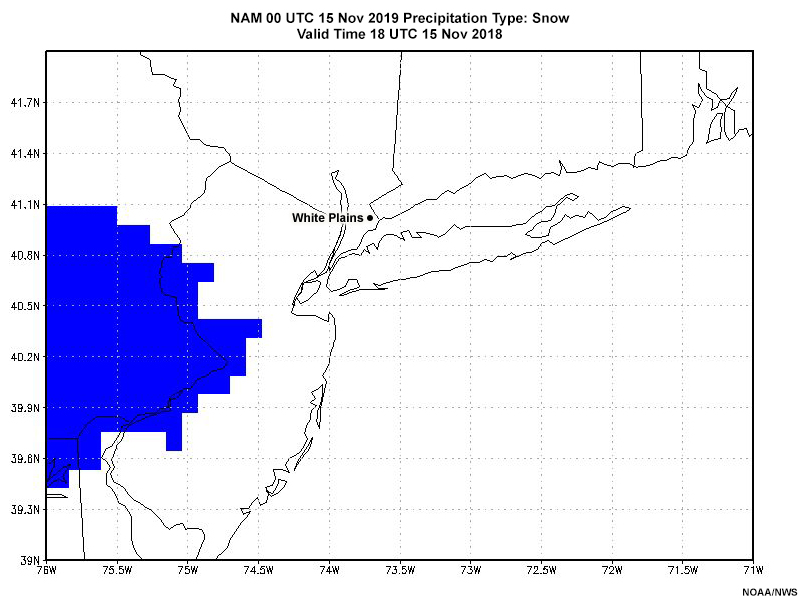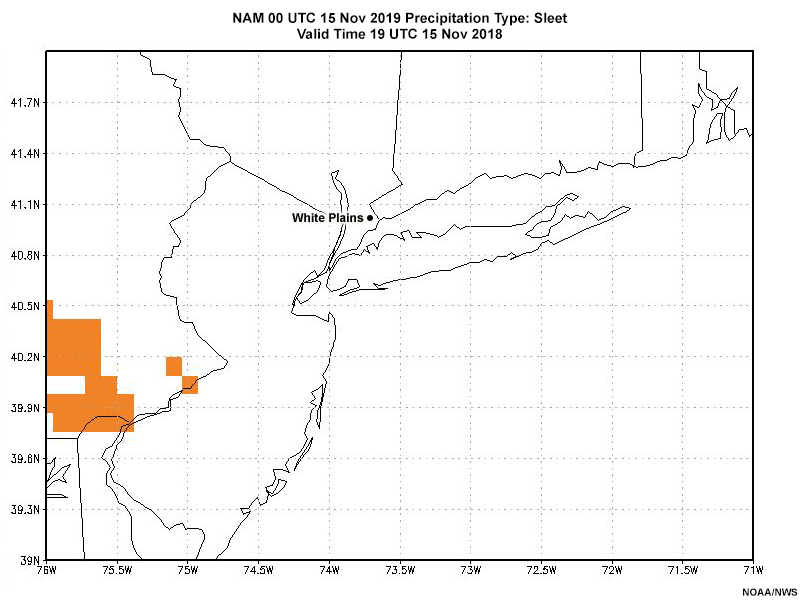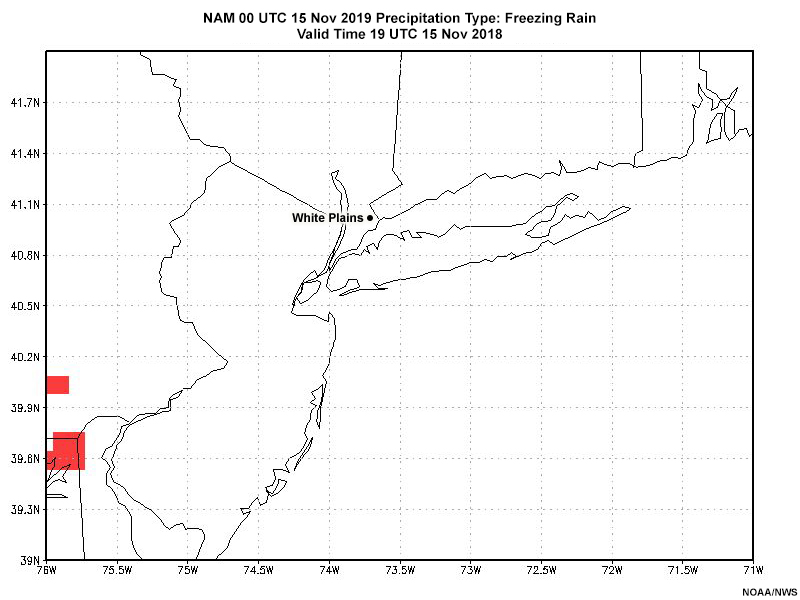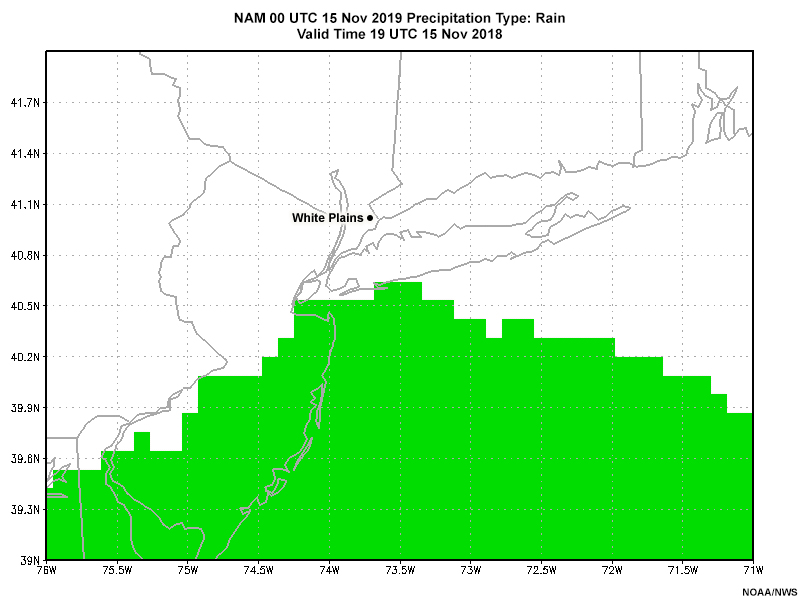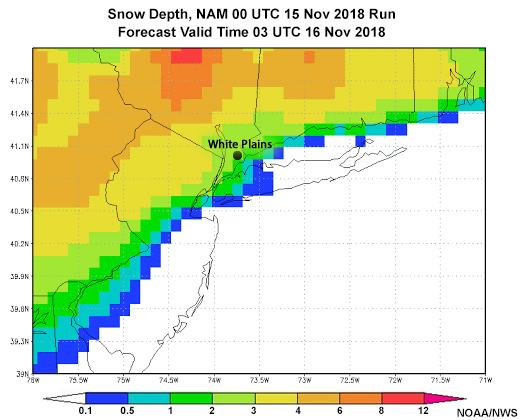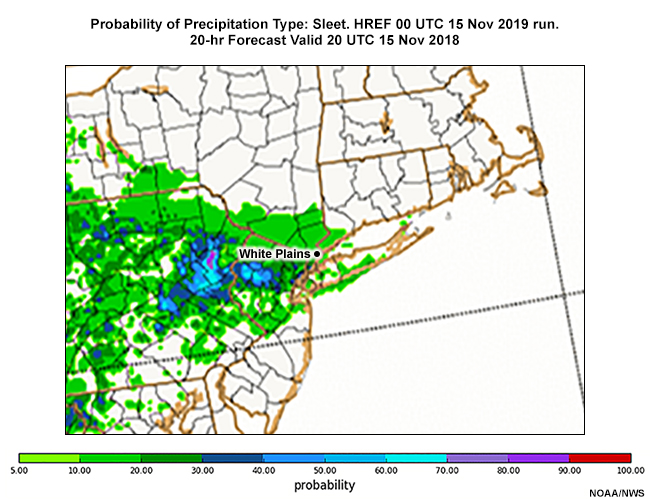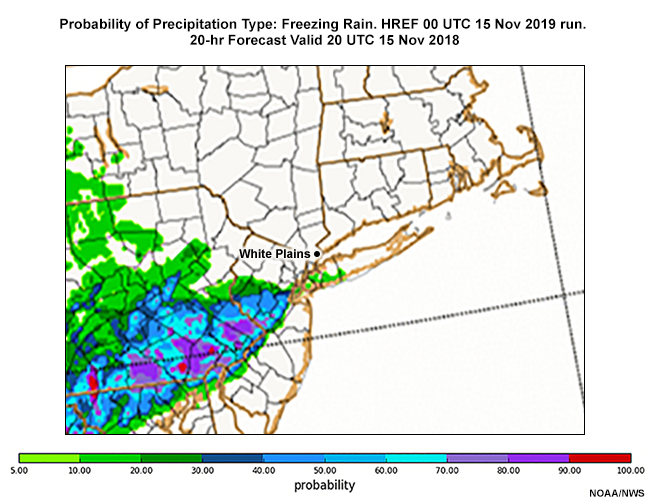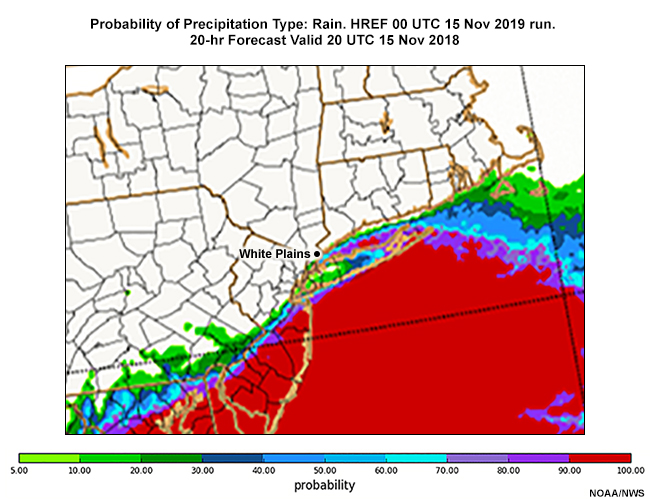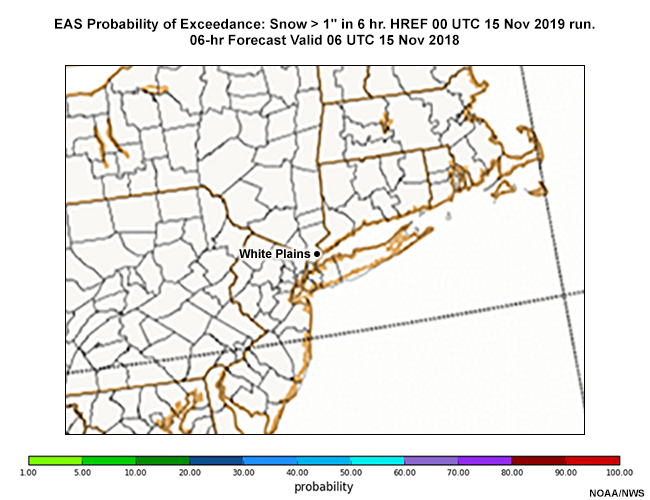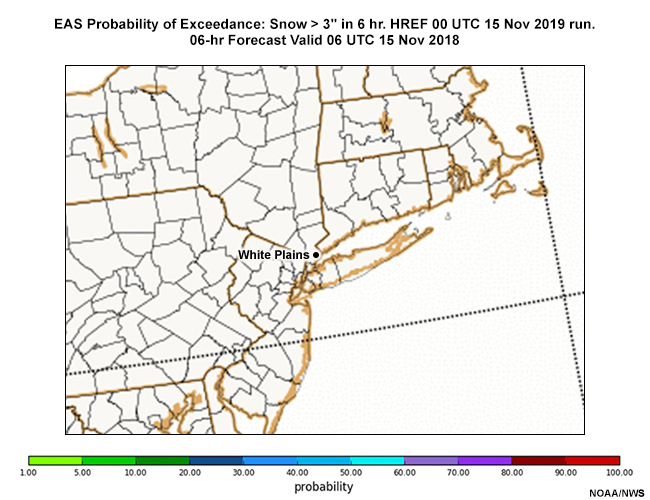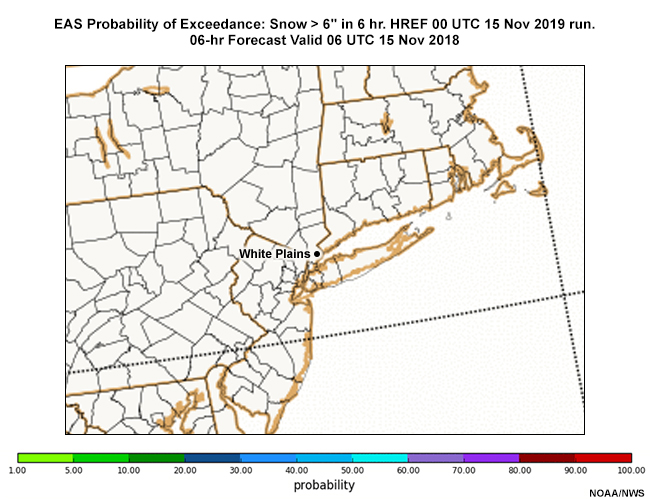Introduction
High-Resolution Ensemble Forecast (HREF) systems are the next generation of ensemble prediction systems (EPS). HREFs use convection-allowing models (CAMs) to provide high-resolution probabilistic forecast information, including the location of mesoscale precipitation bands, and the probability of exceeding important temperature, precipitation, and wind thresholds at the scale of the HREF.
Many of you are familiar with using the Environmental Modleling Center (EMC) HREF from the National Centers for Environmental Prediction (NCEP) for severe weather guidance. In the cold season, however, different forecast problems arise. Snowfall and ice accretion rates depend on Quantitative Precipitation Forecasting (QPF) and the vertical structure of temperature and moisture. Frontogenetic forcing and conditional symmetric instability can result in heavy mesoscale precipitation bands. Precipitation type (ptype) forecasts are critical for assessing social and economic impacts of winter weather. Timing of ptype changeovers, precipitation onset, and precipitation conclusion are all important aspects of potentially high-impact winter weather.
For Impact-based Decision Support Services (IDSS), many emergency managers and other NWS core partners base decisions on specific thresholds for snow accumulation, temperature, and other weather elements. Probabilistic forecasts can help inform the likelihood that these thresholds are met; more so when the data is bias corrected. However, the best results are obtained when the probabilities are all calibrated to the verification probabilities. Presently, the forecast data in the HREF are only bias corrected, so the probability of exceedance should be used with caution.
You might ask, ”Since CAMs are so realistic, why not just use a single CAM forecast?” Just as in coarser-scale NWP, uncertainty comes into play. Model and initial condition imperfections increase forecast uncertainty in the timing, intensity, and location of winter weather features. HREFs allow you to quantify this inevitable forecast uncertainty and to assess the amount of confidence you should place in the forecasts for a potential winter weather event. In this lesson, you will see how to use and interpret HREF winter weather products to address these winter forecast problems.
This lesson includes the following sections:
- A description of the HREF produced at the EMC;
- The types of products currently provided for winter weather guidance;
- A case example where the probabilistic winter weather guidance is used in a winter storm situation
We will also provide web links to additional information on statistical methods used to produce the weather elements available from the HREF, including:
The EMC HREF
The EMC HREF » General Description
The EMC HREF was first developed in 2015 to provide probabilistic convective forecast guidance. With its capability to forecast mesoscale precipitation banding, topographically forced precipitation, and other terrain effects, the HREF can also provide useful probabilistic guidance for winter weather. The convection-allowing models (CAMs) used in the daily 00 and 12 UTC HREF cycles are shown in the graphic below, including the source for the initial conditions.
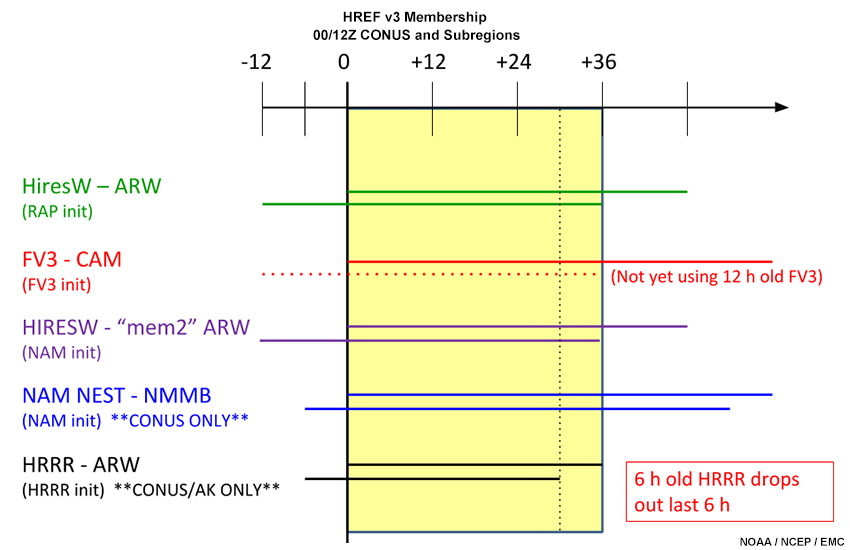
There are items several worth noting:
- As can be seen in the schematic, the HREF is a time-lagged ensemble. Its membership includes the two most recent runs of the five models indicated in the graphic. The lagged members are given less weight in computing ensemble mean quantities. Details for the current operational HREF (v2.1) are found in the MetEd Operational Model Encyclopedia under the Probabilistic Models link.
- As of summer 2019, the FV3 - CAM, while being used as an ensemble component, is not yet formally approved and implemented.
- EMC HREF version 3 (HREF v3) is expected to be made operational in Fall 2020.
- The National Weather Service Storm Prediction Center (SPC) independently runs an HREF with several of the same members and many of the same winter weather products.
- For the sake of simplicity, all future reference in this lesson to "HREF" refers to the EMC HREF v3.
The EMC HREF » High-Resolution Probabilistic Winter Products from HREF
The screen capture below shows the variables available from HREF. Variables in the blue boxes are directly or indirectly meaningful to winter weather forecasting.
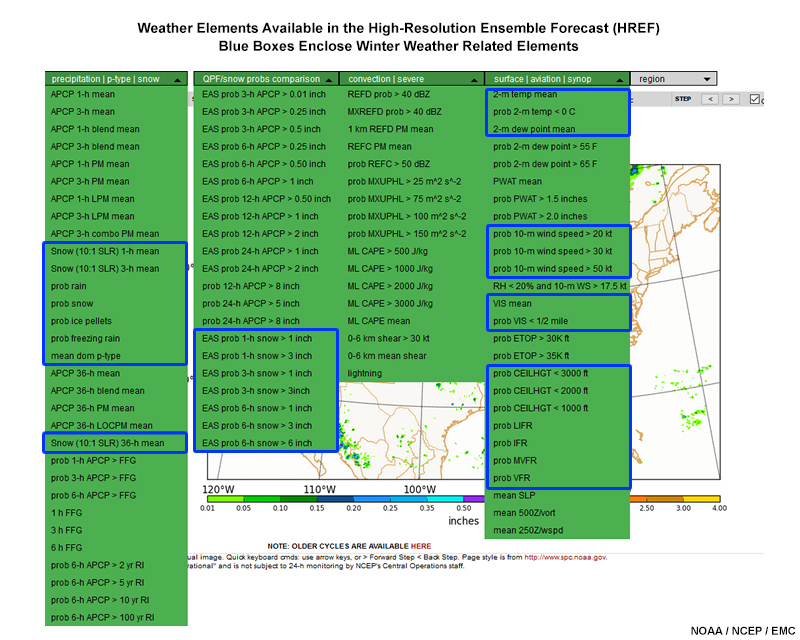
Along with ensemble-mean weather elements, the HREF has probabilistic products, including:
- Probabilistic ptype (not conditional; available in AWIPS)
- EAS neighborhood probability of exceedance for snowfall
- Probability (point) of exceedance for wind speed, ceilings, visibility < ½ mi, and temperature < 0°C (many available in AWIPS)
Application of Probabilistic Winter Weather Guidance
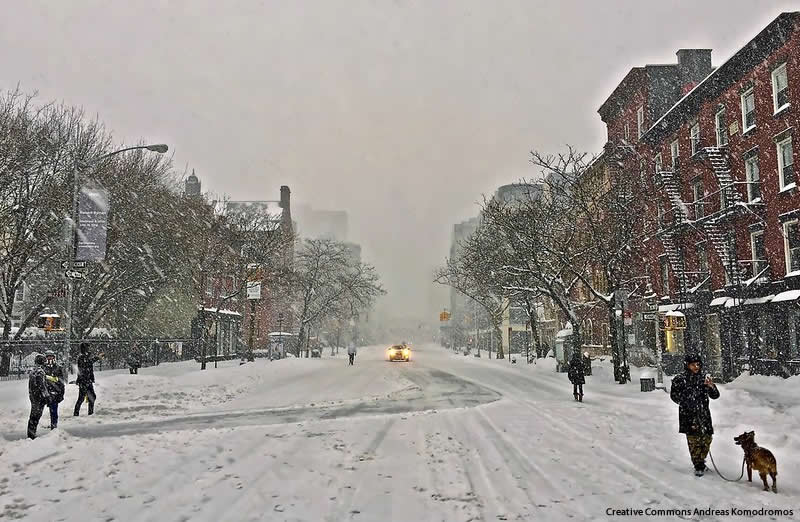
November 2018 was a chilly, wet month in the Northeastern U.S. On 15-16 November, an early season snowfall occurred that overperformed in accumulation and duration east of the Appalachian mountains because of a delay in an expected changeover from snow to rain. HREF v3 was available as a parallel version of the then-operational HREF to provide probabilistic winter weather guidance for days 1 and 2 (0 to 36 hours). In the next several sections, you’ll see examples of how to use the HREF probabilistic guidance for a series of forecast problems tied to this weather event.
Application of Probabilistic Winter Weather Guidance » Precipitation Type Determination and Transition
Forecaster Fran works as the Warning Coordination Meteorologist (WCM) at WFO New York, NY (OKX), serving the New York City area. As such, she is the focal point for communicating significant weather impacts to the jurisdictions in the county warning area (CWA). A map of the area of responsibility is shown below.
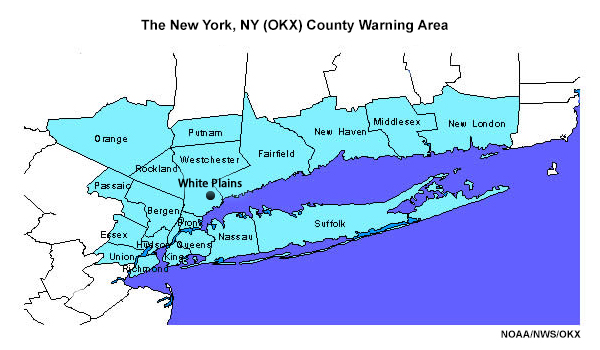
Fran is on the 14-15 November OKX overnight shift, and is monitoring the forecast for the upcoming day (15 November). As of early evening on 14 November 2018, the afternoon forecasters had issued winter weather advisories everywhere other than the New York City boroughs; Hudson County, NJ; and Long Island. Expected snow accumulations were less than 4” in the CWA and no winter storm watches or warnings were issued. The map below summarizes the CWA forecast of accumulations from 15 UTC 15 November through 12 UTC 16 November.
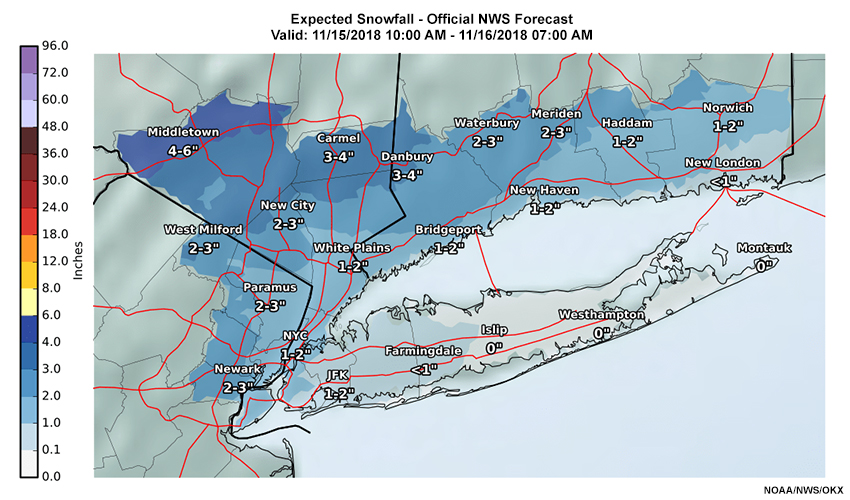
Application of Probabilistic Winter Weather Guidance » Precipitation Type Determination and Transition » Deterministic Guidance
First, Fran wants to look at the deterministic guidance from the 00 UTC 15 November 12 km NAM (NAM12). Here’s what that guidance shows for the predominant ptype and snow accumulation for forecast valid times 19 UTC 15 Nov through 05 UTC 16 Nov.
Note the location of White Plains, NY. We’ll focus on this location for the remainder of this exercise.
Question
Based on the NAM deterministic ptype and hourly change in snow depth (proxy for hourly snowfall), how would you characterize the forecast precipitation type between 21 UTC 15 November and 04 UTC 16 November in White Plains, NY?
The correct answer is a.
The ptype starts as snow, and transitions through a wintry mix from 00 through 02 UTC to become rain at around 03 UTC.
Application of Probabilistic Winter Weather Guidance » Precipitation Type Determination and Transition » Probabilistic Guidance - Precipitation Type
The HREF 00 UTC 15 November 2018 probabilistic guidance posts to the EMC website as expected. Fran checks where the NAM deterministic guidance falls with respect to the HREF probabilistic guidance. She reviews its ensemble mean and probabilistic guidance, keeping in mind the chances of high impact conditions and the potential need for IDSS as she considers the forecast problems associated with a winter storm.
Question
As Fran considers the impending winter storm, which of the following questions should she consider in her forecast process? Choose all that apply.
The correct answers are a, b, c.
Concern is about various hazardous precipitation types: snow, sleet, and freezing rain. It matters where and what time the hazardous precipitation will occur, as these matter as to the impact the precipitation will have. While Fran will be in contact with the emergency manager as the storm unfolds, she gives them the information so that they can make decisions on how roads should be treated.
Fran examines the ptype point probabilities from the HREF run for snow, sleet, freezing rain, and rain. These are all displayed in tabs below. After reviewing these probabilities, answer the question that follows.
Prob Snow
Prob Sleet
Prob ZR
Prob Rain
Unsure of what this product is showing? See Conditional vs Unconditional Ptype Probability
For White Plains NY, (WP on maps) select the probabilities for each ptype at 21 UTC 15 November and again at 00 UTC 16 November 2018.
Question
21 UTC 15 November 2018 ptype probability
Here are the approximate values for each ptype for White Plains, NY. For reference, other locations in the New York City Metropolitan area have also been included.
|
Forecast Ptype Probabilities (%) at 21 UTC 15 November and 00 UTC 16 November 2018 |
||||||||
|
Precipitation Type |
||||||||
|
Snow |
Sleet |
Freezing Rain |
Rain |
|||||
|
|
21 UTC |
00 UTC |
21 UTC |
00 UTC |
21 UTC |
00 UTC |
21 UTC |
00 UTC |
|
White Plains, NY |
>90 |
40 |
0 |
0 |
<10 |
30 |
0 |
30 |
|
Danbury, CT |
70 |
50 |
10 |
20 |
0 |
30 |
0 |
0 |
|
Elizabeth, NJ |
60 |
10 |
20 |
20 |
10 |
20 |
10 |
50 |
|
Hempstead, NY |
50 |
20 |
<10 |
10 |
<10 |
0 |
40 |
70 |
Fran noted, “Looks like a decidedly mixed precipitation situation, starting close to the immediate coast and then moving inland. Typical for an early season storm, and the still-warm Atlantic waters. I’d better take a look at the probability of exceeding snow accumulation thresholds.”
Application of Probabilistic Winter Weather Guidance » Precipitation Type Determination and Transition » Probabilistic Guidance - Ptype Changeover
Prob Snow
Unsure of what this product is showing? See Conditional vs Unconditional Ptype Probability
Prob Sleet
Unsure of what this product is showing? See Conditional vs Unconditional Ptype Probability
Prob ZR
Unsure of what this product is showing? See Conditional vs Unconditional Ptype Probability
Prob Rain
Unsure of what this product is showing? See Conditional vs Unconditional Ptype Probability
“As the saying goes,'' Fran thinks, “timing is everything, and so is location. Evening rush hour in the metropolitan area generally runs from about 3 p.m. to 9 p.m. local time (20 UTC to 02 UTC). To better brief the local emergency managers, I need to check out when the precipitation changeovers will take place.”
Question
Regarding ptype guidance from the HREF in White Plains NY, which of the following statements are true? Choose all that apply.
The correct answers are a, b, e.
According to the HREF, the probability for snow is high from 19 UTC through 00 UTC. There are low probabilities of freezing rain or sleet between 20 UTC and 02 UTC. Rain is in the mix starting at 22 UTC, with the probability exceeding 50% by 02 UTC.
Application of Probabilistic Winter Weather Guidance » Accumulating Snowfall
To address the uncertainty introduced in the deterministic forecast by the snow accumulation gradient, Fran looks for the exceedance probability data. The HREF provides Ensemble Agreement Scale neighborhood probability of exceedance maps for:
- 1 inch accumulations over a 1-hour period,
- 1 and 3 inch accumulations over a 3-hour period, and
- 1, 3, and 6 inch accumulations over a 6-hour period.
Fran decides to use the 6-hour probability of exceedance for the 1”, 3”, and 6” thresholds for the OKX CWA valid at 03 UTC to guide her decisions on snow accumulation updates for tomorrow’s evening rush. Forecasts valid at 03 UTC (10 p.m. local time) from the 00 UTC 15 November forecast runs are found in the tabs below. The maps below are zoomed in to the OKX CWA to provide more detail. Review those forecasts, then answer the question that follows.
EAS Prob 6-hr Snow > 1”
Unsure of what this product is showing? See Probability of Exceedance and Point, Neighborhood, and EAS Probability
EAS Prob 6-hr Snow > 3”
Unsure of what this product is showing? See Probability of Exceedance and Point, Neighborhood, and EAS Probability
EAS Prob 6-hr Snow > 6”
Unsure of what this product is showing? See Probability of Exceedance and Point, Neighborhood, and EAS Probability
Question
For White Plains NY, choose the probabilities closest to each snow accumulation threshold at 03 UTC 16 November 2018.
Here are the approximate values for each threshold in White Plains NY, and other locations in Connecticut, New Jersey, and Long Island.
|
Forecast Probabilities (%) 03 UTC 16 November 2018 |
||||||
|
Prob Snow Exceedance |
||||||
|
|
>1” / 6 hrs |
>3” / 6 hrs |
>6” / 6 hrs |
|||
|
White Plains, NY |
>90 |
80-90 |
50-60 |
|||
|
Danbury, CT |
>90 |
>90 |
70-80 |
|||
|
Elizabeth, NJ |
>90 |
~70 |
40-50 |
|||
|
Hempstead, NY |
50-60 |
30-40 |
10-20 |
|||
Application of Probabilistic Winter Weather Guidance » Accumulating Snowfall » Forecast Implications
ERROR #6b: Graphic completion status for fileID=70572 is needs review. To access the MSDB for the image go here: 70572
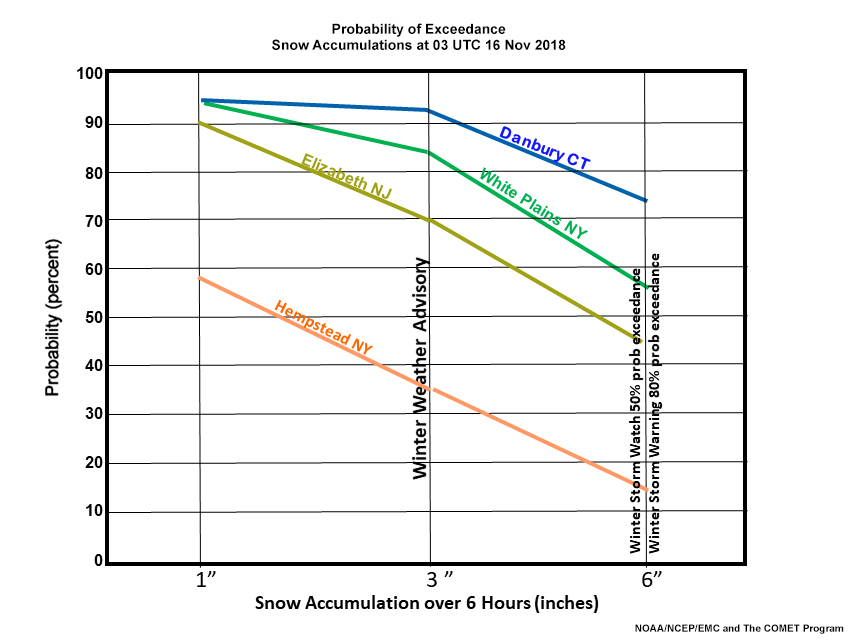
Fran plots the probability of exceedance distributions from this data to make it easier to visualize. The resulting graph is shown above. She then decides she has enough probabilistic forecast information to draw conclusions about possible storm scenarios, particularly for the evening rush hour (3 p.m. to 9 p.m. or 20 to 02 UTC).
First, she compares the probabilistic HREF forecast to the deterministic NAM forecast she reviewed earlier to see where it is in the full ensemble distribution.
Question
Recall that the total snow accumulation in the deterministic NAM12 from 00 UTC 15 November 2018 was about 2” in White Plains, NY, before the changeover to rain at about 01-02 UTC 16 November. At 03 UTC 16 November 2018, what is the approximate forecast probability of exceeding the 2” forecast based on the HREF range of forecasts? Choose the best answer.
The correct answer is d.
ERROR #6b: Graphic completion status for fileID=70573 is needs revision. To access the MSDB for the image go here: 70573
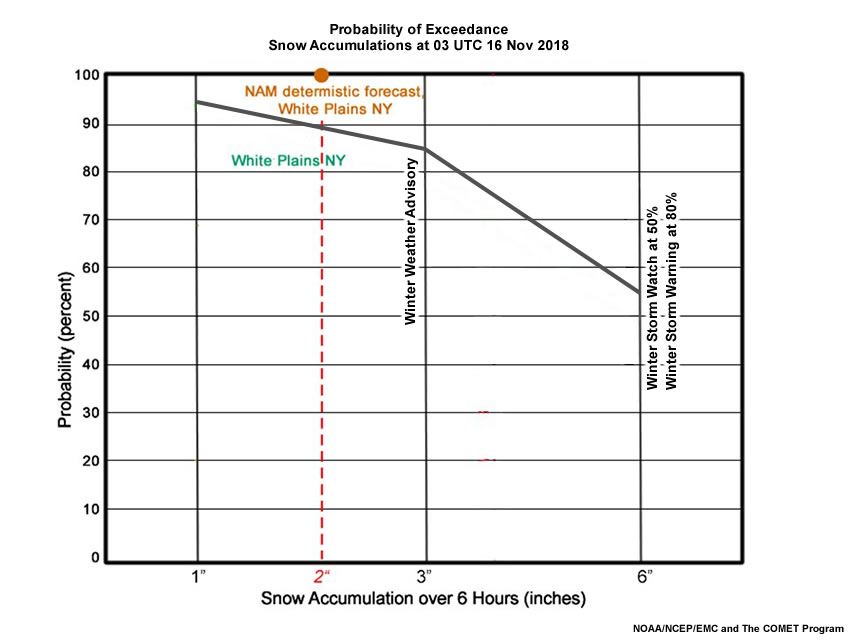
Fran placed the 2” value from the deterministic NAM forecast on the probability of exceedance diagram she prepared earlier. The 2” value intersects the White Plains NY probability of exceedance curve at ~90%, indicating a ~90% probability of exceeding 2”. Note also that the probability of exceedance at the winter storm threshold of 6” is 55%.
The HREF accumulates snow and sleet using a 10:1 snow-to-liquid-ratio (SLR), while the observed SLR for sleet is typically around 2:1 to 3:1. Therefore, Fran would be prudent to recheck how much sleet is included as a ptype especially in mixed precipitation situations such as this one.
There is only a slight chance of sleet before 00 UTC, Fran recalls. But sleet probabilities increase to about 40% before rain completely takes over by 03 UTC. Fran may consider reducing the HREF probability of accumulations exceeding 1”, 3”, and 6” because:
- There will be some minor amounts of sleet after 00 UTC that will slightly cut down accumulations;
- Climatologically, snow amounts of this magnitude are rare in mid-November.
Application of Probabilistic Winter Weather Guidance » Guidance for Watches, Advisories, and Warnings
Fran now has to decide how to modify the forecast. She looks again at the HREF snow exceedance probabilities she previously plotted.
ERROR #6b: Graphic completion status for fileID=70572 is needs review. To access the MSDB for the image go here: 70572

Question
Which of the following statements are true?
The correct answers are a, d.
The HREF indicates that snow amounts will be significantly higher than forecast by the NAM, particularly in the northern and western parts of the CWA, where the probability of exceeding the 6” threshold is greater than 50%. NWS Directives state 50% confidence in meeting criteria for issuance of a watch and 80% confidence for issuance of a warning.
Relying on this information, Fran issues a Winter Storm Watch for the CWA, calling for 4-8” of snow in the north and west parts of the CWA. While the south and east parts of the CWA, particularly Long Island, are expected to see mostly rain, there is a significant chance of snow there reaching the advisory criterion. Given the potential impacts of a rush hour storm, Fran extends the watch to these areas as well.
Application of Probabilistic Winter Weather Guidance » Verification
The accumulated snowfall as of 09 UTC 16 November 2018, is shown in the map from the New York, NY WFO below.
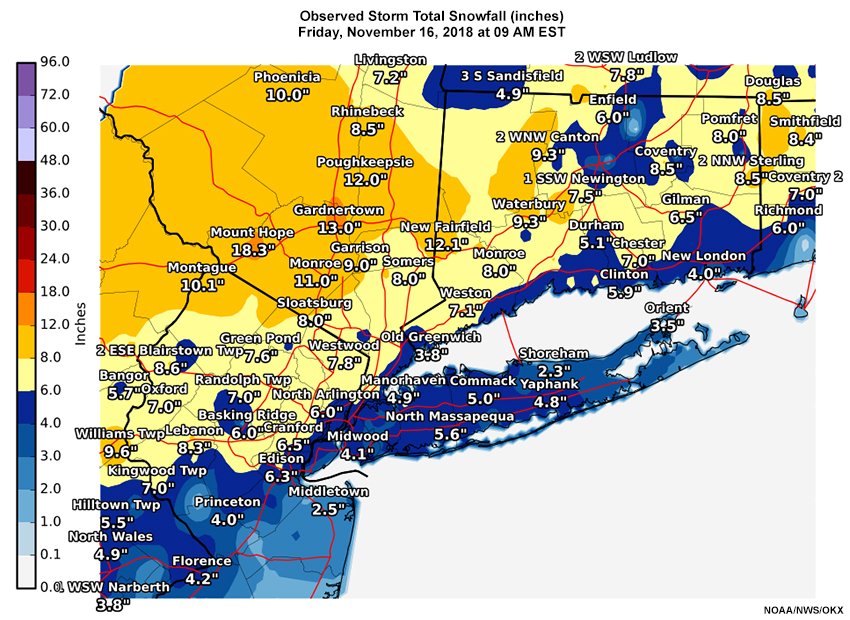
Summarizing the forecast versus observations:
- Underforecasting of snow was mostly the result of heavy initial snowfall rates (up to 2” or more per hour) and a delay in snow changing to rain in places along the coast (e.g., Long Island, NYC, eastern NJ, southern CT).
- New York City’s Central Park, with records from 1869 to the present, had its earliest 6” snowfall on record. Many other locations in the area broke early season records.
- The HREF was more useful as its range of forecasts captured the heavier than expected snowfall in most of the CWA. The area generally received snow amounts toward the high end of what was expected, in line with the high end of the HREF forecast.
Application of Probabilistic Winter Weather Guidance » Case Summary
This lesson walks the student through an early season snowstorm as it moved through the New York City area. The case study includes using the HREF products to assess start and precipitation changeover times, a rough range of snow accumulations over the evening rush hour, and the subsequent verification. It is demonstrated that, at least in this case, the HREF allowed for more helpful guidance by providing a “heads up” that high impact snow accumulations were possible in areas south of the deterministic guidance.
Important Statistical Concepts
Important Statistical Concepts » Probability of Exceedance
Probability of exceedance (PE) guidance quantifies the forecast risk that some critical meteorological threshold will be crossed. PE is determined by using a cumulative distribution function (CDF). The source of the CDF can be either empirical (defined directly by the data) or based on an expected distribution that best fits the data sample.
PE is used at critical thresholds for temperature, precipitation, or wind. In the cold season, PE is generally used for winter storms, heavy snow, winter weather advisories, ice accumulation, winds, temperatures (below freezing and below zero), and wind chill.
An example of such a CDF is shown below. Examine it and, recalling the definition of probability of exceedance, answer the question that follows.
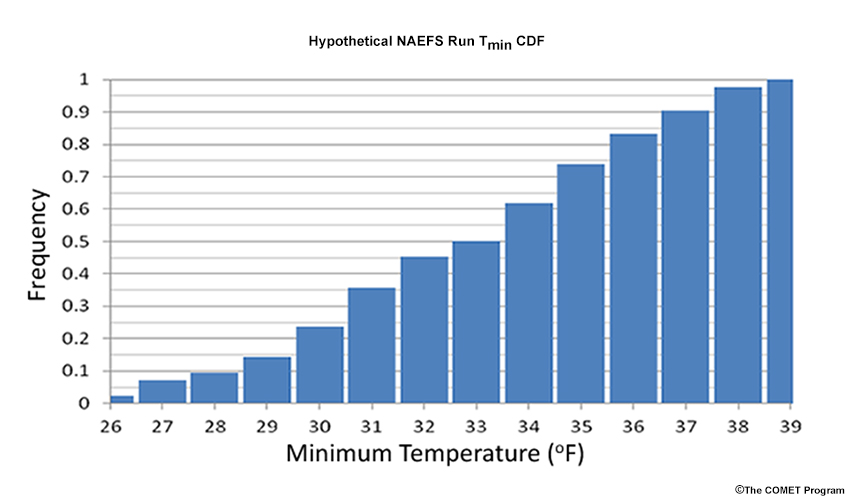
Question
You are tasked with drafting warnings for agricultural interests and decide to use the North American Ensemble Forecast System (NAEFS) based on the following:
- A hard freeze warning is issued for minimum temperatures (Tmin) of 28°F or less,
- A freeze warning for Tmin from 29° to 32°F, and
- A frost advisory for Tmin from 33° to 37°F.
If more than one warning/advisory meets the criterion, the one with the biggest agricultural impact is issued.
From the CDF above of overnight minimum temperatures, what is the probability of each temperature range?
The frequencies from the histogram are cumulative, and refer to the occurrence up to the value indicated. So, there is a 10% chance that the temperature will be 28°F or less, 45% chance of 32°F or less, and 90% chance of 37°F or less.
The probability of exceedance for some threshold value can be plotted on a map for any winter weather element at every grid point. Such guidance can be used to determine if winter storm warnings or winter weather advisories are needed.
Question
Assume a 50% probability of more than 1” over six hours is required for winter weather advisory issuance in the Memphis TN CWA (enclosed by the red boundary), and that no snow is expected before or after this six-hour period. Using the black pen below the diagram,
Circle the portion of the Memphis TN CWA that meets the threshold for a winter weather advisory.
Only a small area in the east-central part of the Memphis TN CWA meets the criteria for a winter weather advisory. That area is enclosed by a white oval in the graphic below.
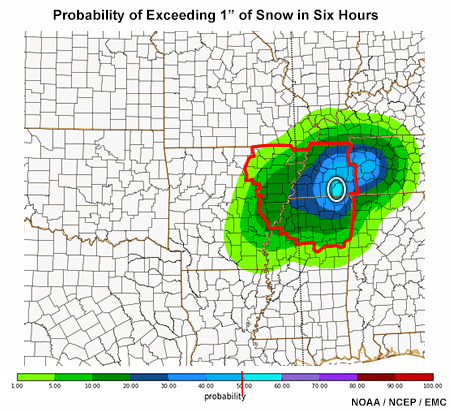
Important Statistical Concepts » Conditional vs Unconditional Ptype Probability Example
Suppose we have a 20-member ensemble. The forecast at some time has a probability of precipitation of 60%. Thus 12 members show some precipitation, while 8 others do not. Now suppose that the members that show precipitation have a variety of precipitation types, including rain, sleet, and snow. We might end up with a distribution like this:
|
Number of |
|
|
No Precip |
8 |
|
Rain |
6 |
|
Sleet |
4 |
|
Snow |
2 |
The conditional probability of rain states that if there is precipitation, what is the probability of rain (versus freezing rain, sleet, or snow), whereas the unconditional probability of rain says that regardless of whether there is precipitation or not, what is the probability of rain.
Question
What are the conditional and unconditional probabilities of rain in this example?
Precipitation occurs in 12 of the 20 ensemble members, which equals the overall probability of precipitation. Rain occurs in 6 of the 12 ensemble members that predict precipitation.
Thus the conditional probability of rain is 6/12 = 50%. The unconditional probability of rain includes the possibility that there may be no precipitation. Rain occurs in 6 of the 20 total ensemble members. Thus the unconditional probability of rain is 6/20 = 30%.
Note that the conditional probabilities will sum to 100%, but the unconditional probabilities will only sum to 60%.
Important Statistical Concepts » Point, Neighborhood, and EAS Probability
Important Statistical Concepts » Point, Neighborhood, and EAS Probability » Point Probability
In probability, an event is a subset of outcomes that meet a requirement (e.g., winds exceeding 35 kt at a single location), to which a probability may be assigned. In an ensemble prediction system, the most simple probability is the number of ensemble members containing an event at some grid point.
The table below shows a wind forecast for a single point for an ensemble with 10 members.
|
Ensemble Member |
Wind < 35 kt |
Wind >= 35 kt |
|
Mbr 1 |
x |
|
|
Mbr 2 |
x |
|
|
Mbr 3 |
x |
|
|
Mbr 4 |
x |
|
|
Mbr 5 |
x |
|
|
Mbr 6 |
x |
|
|
Mbr 7 |
x |
|
|
Mbr 8 |
x |
|
|
Mbr 9 |
x |
|
|
Mbr 10 |
x |
Question
What is the point probability of wind speeds of 35 kt or greater?
The correct answer is b.
Four of 10 members (40%) indicate the defined event is forecast. Here the defined event is winds greater than or equal to 35 kt. It could just as easily be 6 inches of snow or temperature less than 0°F.
Important Statistical Concepts » Point, Neighborhood, and EAS Probability » Neighborhood Probability
Mesoscale weather systems frequently exhibit uncertainty in location. For example you may be expecting scattered convection, but you don’t know exactly where the convection will set up. One way to account for this uncertainty is to look to the area surrounding a grid box for occurrences of an event of interest. If the area around the grid box has a fixed radius of 40 km, then you could account for the probability of an event (e.g., measurable precipitation) within 40 km of that grid box. A neighborhood probability is one way to do this. You’ll find a schematic of the neighborhood probability method below.

Suppose, for example, that you expect heavy banded snow one afternoon, with snowfall exceeding three inches in three hours. This defines our event. The neighborhood is an area around each grid cell with a defined radius, typically 40 km. Given a 5-member ensemble, if a member has a grid cell that meets our event criteria, snowfall exceeding three inches in three hours, anywhere in the neighborhood, then that is a positive match. In the example shown above, the circle is the neighborhood. Red grid cells indicate 3-hr snowfall > 3 inches. If 3 of the 5 members meet this criteria, as shown here, then we say the neighborhood probability is 3/5 = 60%.
Important Statistical Concepts » Point, Neighborhood, and EAS Probability » Fractional Coverage and the Ensemble Agreement Scale (EAS)
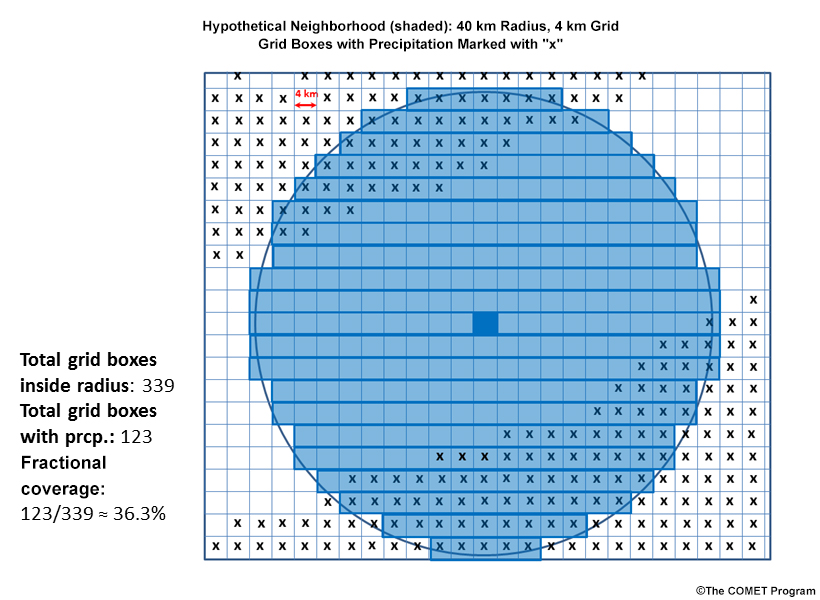
In this graphic example we see two hypothetical bands of precipitation denoted by “x”s, north and south of the neighborhood's central grid box in darker blue. Precipitation occurs in 123 of the 339 grid cells within 40 km of our grid cell. And thus we say that there is a 123/339 = 36% probability of precipitation within 40 km of this grid box. We call this fractional coverage. It acts to smooth the probability contours.
A variant of the fractional coverage metric is the Ensemble Agreement Scale (EAS). It’s similar to fractional coverage, but uses a full ensemble and a variable radius. Where the difference between ensemble members is small, the radius is small. As the difference between ensemble members increases, the size of the radius similarly increases. The EAS probability seeks to preserve information about the confidence in location when ensemble members agree. This method can be particularly useful in cases of orographic or coastally influenced weather. The EAS probability tends to preserve features associated with terrain and coasts that might otherwise be smoothed out.
How does this work in practice? Starting with a radius of one grid cell around a point, the similarity of the ensemble members is computed. If they are sufficiently similar, then the probability for that radius is calculated. If not, then the radius is increased to 2 grid cells and the similarity of the ensemble members is computed and evaluated for the expanded area. This process is repeated until the smallest radius is found that satisfies the similarity criteria (the ensemble agreement scale). A fractional coverage probability is then calculated for that radius (Blake et al., 2018).
Compare point probability with an EAS probability plot for 3-hour snow accumulation greater than 1” and then answer the question that follows.

Question
The EAS versus point probabilities for 3-hour snow greater than 1” show some differences. Which of the following statements is true with respect to those differences? Choose all that apply.
The correct answers are b, d.
Point probabilities result in increased area coverage of high probabilities and lowers the area coverage of low probabilities, while EAS reduces the area coverage of high probabilities and increases the area of low probabilities. This is a consequence of taking the uncertainty measured by the EAS into account. Another consequence of EAS is the decrease in the sharpness of gradients as can be seen along all edges of the precipitation area.
Summary
This lesson demonstrates the use of HREF probabilistic guidance in an early season snowstorm that struck the New York City area. In this case, the probabilistic guidance outperformed deterministic guidance from the NAM, pointing to a solution with a later changeover from snow to rain that contributed to higher snow accumulations than in the deterministic forecast.
HREF forecast products use a variety of statistical methods including conditional and unconditional probability of ptype and point and EAS neighborhood probability of exceedance. While unconditional probability includes all weather types in computing the chance of a precipitation type, conditional probability only includes ensemble members with precipitation only. This provides forecasters, emergency managers and other end users with risk assessment information under a narrower set of conditions. The probability of ptype allows forecasters and end users to assess the impact of a possible winter weather event based on the timing of winter precipitation onset and ptype changeovers.
The neighborhood methods measure the risk of exceeding critical thresholds for accumulating snow and ice. This helps both with assessing the need for winter weather watches, warnings, and advisories, and the confidence that the forecaster may place in the HREF probability of exceedance forecasts. The EAS methodology adapts to the amount of agreement among the HREF ensemble membership, which arguably makes EAS the best tool for both probabilistic forecasts and IDSS.
Contributors
COMET Sponsors
MetEd and the COMET® Program are a part of the University Corporation for Atmospheric Research's (UCAR's) Community Programs (UCP) and are sponsored by
- NOAA's National Weather Service
(NWS)
with additional funding by: - Bureau of Meteorology of Australia (BoM)
- Bureau of Reclamation, United States Department of the Interior
- European Organisation for the Exploitation of Meteorological Satellites (EUMETSAT)
- Meteorological Service of Canada (MSC)
- NOAA National Environmental Satellite, Data and Information Service (NESDIS)
- NOAA's National Geodetic Survey (NGS)
- National Science Foundation (NSF)
- Naval Meteorology and Oceanography Command (NMOC)
- U.S. Army Corps of Engineers (USACE)
To learn more about us, please visit the COMET website.
Project Contributors
Project Lead and Instructional Design
- Dr. Alan Bol
Project Scientist
- Dr. William Bua
Science Advisors
- James Ladue - NOAA NWS
- Matthew Pyle - NOAA NCEP
- Trevor Alcott - NOAA ESRL
- Kevin Scharfenberg - NOAA NWS
- David Radell - NOAA NWS
- Peter Banacos - NOAA NWS
- John Boris - NOAA NWS
- Cory Mottice - NOAA NWS
Program Oversight
- Dr. Alan Bol
Graphics/Animations
- Steve Deyo
- Lindsay Johnson
Multimedia Authoring/Interface Design
- Gary Pacheco
COMET Staff, October 2019
Director's Office
- Dr. Elizabeth Mulvihill Page, Director
- Tim Alberta, Assistant Director Operations and IT
- Dr. Paul Kucera, Assistant Director International Programs
- Dr. Wendy Gram, Implementation Manager
Business Administration
- Lorrie Alberta, Administrator
- Auliya McCauley-Hartner, Administrative Assistant
- Tara Torres, Program Coordinator
IT Services
- Bob Bubon, Systems Administrator
- Joshua Hepp, Student Assistant
- Joey Rener, Software Engineer
- Malte Winkler, Software Engineer
Instructional Services
- Dr. Alan Bol, Instructional Designer/Scientist
- Tony Mancus, Instructional Designer
- Sarah Ross-Lazarov, Instructional Designer
- Tsvetomir Ross-Lazarov, Instructional Designer
International Programs
- David Russi, Translations Coordinator
- Martin Steinson, Project Manager
Production and Media Services
- Steve Deyo, Graphic and 3D Designer
- Jordan Goodridge, Student Assistant
- Dolores Kiessling, Software Engineer
- Gary Pacheco, Web Designer and Developer
Science Group
- Dr. William Bua, Meteorologist
- Patrick Dills, Meteorologist
- Bryan Guarente, Instructional Designer/Meteorologist
- Matthew Kelsch, Hydrometeorologist
- Andrea Smith, Meteorologist
- Amy Stevermer, Scientist/Instructional Designer
- Vanessa Vincente, Meteorologist
